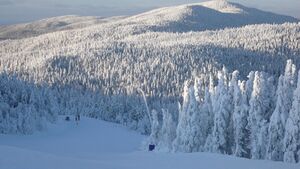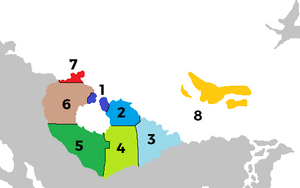Rensselaerswijck
This article is incomplete because it is pending further input from participants, or it is a work-in-progress by one author. Please comment on this article's talk page to share your input, comments and questions. Note: To contribute to this article, you may need to seek help from the author(s) of this page. |
Federal Republic of Rensselaerswijck Bondsrepubliek van Rensselaerswijck | |
|---|---|
| Motto: "Verenigd in democratie. Samen in vrijheid." "Unity in democracy. Together in freedom." | |
| Anthem: "Stormvogels" | |
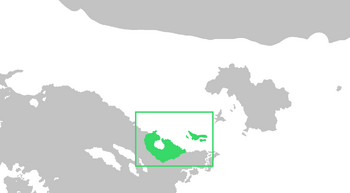 Rensselaerswjick, in light green. | |
| Capital and largest city | Nieuw Hoop |
| Official languages | Rensselaer Freijian (dialect)
Freijian |
| Recognised regional languages | Cree |
| Ethnic groups | 1. Rensselaer
2. Alqonquain 3. Freijian |
| Religion | Secular State |
| Demonym(s) | Rensselaer |
| Government | Bondsrepubliek (Federal Republic) |
| Willem Lodewijk | |
| Hamilton Van Rensselaer Fairfax | |
| Legislature | Rensselaer Parlement van Het Volk |
| Independence from Freijian | |
• Declared | May 21st, 1811 |
| July 1st, 1814 | |
| Population | |
• 1930 census | 2,324,937 |
| GDP (PPP) | estimate |
• Total | $8.336 Billion |
| Currency | Rijksdaalder (R$) |
| Driving side | left |
Rensselaerswijck, officially known as the 'Federal Republic of Rensselaerswijck (Rensselaer Freijian: Bondsrepubliek van Rensselaerswijck) is a sovereign nation located in northern Hibernia. Rensselaerswijck is bordered by Volkhov to the west, Alinora to the southeast, and Nørräland to the north across the Ansulation ocean. The Federal Republic is made up of 6 provinces, various indigenous reservations, and an incorporated island territory. It encompasses an estimated 2.3 million citizens as of the 1930 census, which mainly live on the Eastern coast along with the majority of Rensselaerswijck's largest cities. Heading further from the coast sprawling with infrastructure and densely populated cities presents a very remote, depopulated and unforgiving wilderness which stretches for hundreds of miles. Little to no organized infrastructure is found in the depths of the Rensselaerswijck wilderness, but it is the subject of an immense fur and pelt industry. It attempts to distinguish itself as one of the most successful democracies in all of Hibernia, if not all of Verthandi.
Rensselaerswijck is a Federal Republic with 6 administrative regions known as provinces. To the north-western reaches of the Republic is the Rensselaerswijck Indigenous Occupation Zone, which is a completely autonomous stretch of territory free from federal law and de-facto acts as a seperate entity free from the state. The capital and largest city in the Federal Republic is Nieuw Hoop (English: New Hope) which both represents the governmental hub of the country as well as the economic hub, being the largest port city in all of the Republic. Nieuw Hoop was granted its own Province in 1899 around surrounding villages and towns, significantly increasing its influence over the rest of the country. Featured in the city are the three, independent branches of government, providing checks and balances upon each other: the Executive branch (led by President Willem Lodewijk), the Legislative branch (led by Deputy President Hamilton Van Rensselaer Fairfax, who leads the nation's single-house proportionally elected Parliament) and finally the Judicial branch (led by the Supreme Court consisting of a panel of 9 elected high judges, who serve terms of twenty years or until a retirement age of 72, whichever comes first.)
Rensselaerswijck has been an independent nation-state for over 100 years, finally gaining independence from the ex-colonial power of Freijian on July 1st, 1814 in the terms of the Treaty of Freijstad. Since gaining independence, the country has strived to become a beacon of democracy and equality under the law. This is why the country has some of the most comprehensive agreements with the indigenous populations who roamed the areas around modern-day Rensselaerswijck before Cybelleum colonization. As a consequence, the Rensselaer identity is shaped by the inclusion of everyone regardless of race, ethnicity, or creed. A distinct culture and language dialect has also been formed from years of distancing from the traditions of Freijian.
Etymology
Rensselaerswijck was named after the prominent land-owning family which surprisingly supported and helped legitimize the May 21st Declaration, effectively the Rensselaerswijck Declaration of Independence. They willingly surrendered their land holdings to the new revolt, while other land-owners resisted and were captured. The family even denounced the now-capitulated government of Freijistad (which had been conquered at this point during the Clementine Wars). Following the Treaty of Freijistad, the newly established Rensselaerswijck Republic agreed to restore all land-owning rights to noble families, under the provision that special privileges would be revoked. The independence of Rensselaerswijck likely would not have been bloodless and effective if it not been the Rensselaerswijck family's help, historians note, which is why the nation was named after the family. The family's bloodline continues to influence the country to this day, with prominent von Rensselaerswijck members holding political office and owning mercantile-based business. The most well-known and arguably influential of the Rensselaerswijck family today remains to be Hamilton Van Rensselaer Fairfax, the nation's Deputy General and statesman. The provinces and towns across the country are a mix of indigenous and Freijian names. Some provinces are named after influential indigenous tribal leaders, while others named after Freijian cities abroad.
Geography and Climate
Geography
The Federal Republic of Rensselaerswijck shares land borders with the Grand Republic of Volkhov and Alinora, with a maritime border with the Ansulation ocean to the North-east and a slight border to the Hyborean ocean heading directly north. All six provinces hold direct sea access, with only one province not having access to the Bay of Rensselaer.
The north eastern coast of the country stands on with varied topography. From Nieuw Hoop eastwards, a broad, flat coastal plain dots the landscape with beaches which are populated in the summer yet frozen over in the winter. As you head westward into the Rensselaer forests, long stretches of uninhabited forest and mountain ranges, the largest of which being the Versche Mountain Range, which roughly follows the border between Volkhov and Rennselaerswijck. To the southeastern most edge of the country is flat plain, in which most of the small agricultural industry is found.
Climate[1]
The country is varied in its climate, reaching moderately warm summers and following with long, intense winters. By summer the beaches of Rensselaerwijck are tourist attractions for native residents alike, while the forests in the Western half of the country open up for safe travel. Scientific records showed that early on in the history of the region in winter, the country is nearly cut off from ocean access, with small sections of the Ansulation ocean not freezing over. The entire Bay of Rensselaer would freeze over into ice in the later months of Winter. Records from 1819 show the Bay froze for over 5 months of the year, killing economic progress in the country. Freezing of the bay has not happened in recent memory, with temperatures managing to stay warm enough for passing trade activity. Depending on year, the country may be colder than normal and develop frost in the bay, but no significant blockage of trade has ever occurred on record in the past 50 years.
| Month | High Temperature | Low Temperature | Precipitation (mm) |
|---|---|---|---|
| January | 20.7F / -6.3C | 3.6F / -15.8C | 83 |
| February | 23.4F / -4.8C | 5.9F / -14.5C | 71 |
| March | 33.3F / 0.4C | 17.1F / -8.3C | 71 |
| April | 47.8F / 8.8C | 30.9F / -0.6C | 71 |
| May | 62.6F / 17C | 41.9F / 5.5C | 80 |
| June | 72.3F / 22.4C | 51.6F / 10.9C | 114 |
| July | 78.4F / 25.8C | 54.1F / 12.3C | 117 |
| August | 74.8F/ 23.8C | 54.1F / 12.3C | 107 |
| September | 65.3F / 18.5C | 46.6F / 8.3C | 105 |
| October | 53.1F / 11.7C | 37.2F / 2.9C | 82 |
| November | 39.0F / 3.9C | 26.8F / -2.9C | 93 |
| December | 24.8F / -4.0C | 10.2F / -12.1C | 107 |
Provinces and Territories of Rensselaerswijck
The "Core Six Provinces"
Rensselaerswjick has six official provinces, which are all represented on the national flag of the country. The six provinces, in no particular order, are the following:
Each constituent province is bounded by political union, holding jurisdiction over the territories they inhabit. Power is shared between both the federal and provincial governments, meaning that citizens of a province are both residents of the province and the country. No checkpoint or border separates the constituent provinces, although some citizens may be barred from leaving one province and entering another due to criminal or judicial reasons. The "Core Six Provinces" are irrevocably enshrined in the Rensselaerswjick constitution, granting the provinces vast autonomy and power in both local and federal matters. Provinces have their own independent, provincial constitutions, grounded in principles similar to the federal Rensselaerswjick constitution. Each province further has their own three branches of government: democratically elected legislature, executive, and judicial branches.
The six provinces are seen as equal entities, and not one province is deemed more important than another. While the provinces do not have a direct say in Federal Government, as the Parliament is elected proportionally based on population, the individual provincial leaders (officially titled Provincial Governors) meet annually to discuss common goals and problems. While provinces can pass their own laws in their own legislature, if both federal and provincial laws conflict, in most cases federal law will prevail.
Special Administrative Zones
There are currently two areas designated as Special Administrative Zones, which do not have the same representation nor powers in government as the provinces. Both locations have seperate degrees of autonomy and usually fall under Federal, not provincial, jurisdictions. The two Special Administrative Zones are:
- RIOZ (Rensselaerswjick Indigenous Occupation Zone), a zone granted to indigenous leaders free from provincial jurisdiction.
- Sint Maarten Islands, an incorporated island chain to the north-east of mainland Rensselaerswjick.
Both Special Administrative Zones are unique in their own way, only grouped up because of their special statuses as territories. The RIOZ, for example, is both governed by Federal and Tribal law. The Sint Maarten Islands, on the other hand, is governed exclusively by Federal law and acts as a province in all but name. Many, especially those on the far-right, support an end to the Special Administrative Zones. Those on the far reaches of the political spectrum view the Rensselaerswjick Indigenous Occupation Zone as "caving to natives", while a wide constellation of politicians from various parties and outlooks have called for the Sint Maarten Islands to officially gain provincehood.
Politics
Current Ruling Government
The current government of Rensselaerswijck is a coalition government between the Republican Unity Party and the Mercantile Interest Party. The President, whom is democratically elected by the people, is Willem Lodewijk. Meanwhile, the Republican Unity Party has the most seats in the Parliament, which made it able to vote in Hamilton Van Rensselaer Fairfax as Deputy President. The government has focused on policies of deregulation, decentralizing the Federal Government, and a Laissez-Faire economic policy.
| Picture | Name | Term | Tenure | Mandate of Office | Affiliation | ||
|---|---|---|---|---|---|---|---|
| 1 | 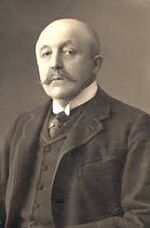
|
Willem Lodewijk President |
1 | 1 December 1929 |
1 February 1931 |
1929 Snap Elections | Mercantile Interest Party |
| 2 | 1 February 1931 |
1 December 1934 |
1930 General Election | Mercantile Interest Party | |||
| 3 | 1 December 1934 |
1 February 1939 |
1934 General Election | Mercantile Interest Party | |||
| 1 | 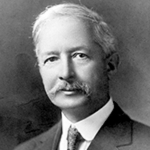
|
Hamilton Van Rensselaer Fairfax Deputy President |
1 | 1 February 1931 |
1 December 1934 |
1930 General Election | Republican Unity Party |
| 2 | 1 February 1935 |
1 December 1938 |
1934 General Election | Republican Unity Party | |||
Political Parties in Rensselaerswijck
Renselaerswijck is a multi-party democracy split between various political parties, ranging anywhere from authoritarian left and right to centrist democratic government. The Parliament consists of 350 proportionally-elected members which need a coalition or outright majority of 175 members to form a government. The current make up of the legislature is seen below, with a coalition government currently formed between the Republican Unity Party and Mercantile Interest Party.
The Republican Unity Party was formed in late 1929 of a coalition of Republican and regionalist parties seeking to greatly lower the authority of the Federal Government in the wake of the Martens Administration Scandal. It won a landslide victory in the 1929 Rensselaerswijck Snap Elections, winning an absolute majority without forming a coalition government. However it lost its absolute majority in the 1930 Rensselaerswijck General Elections, being forced to form a coalition government with the Mercantile Interest Party. Many of its former seats were swooped up by the resurgent Liberal Democratic Bloc, which stands to be the Coalition Government's greatest opposition in Parliament.
| Party | Position | Common Ideals | Leader | Seats in Parliament | Bloc |
|---|---|---|---|---|---|
| Republican Unity |
Centre-Left | Free Trade, Pro-Indigenous Interests, Status-Quo Governing, Neutrality, Expanded Regional Powers | Hamilton Van Rensselaer Fairfax | 135 / 350 |
|
| Mercantile Interest |
Centre-Right | Market Liberalism, Free Trade, Merchant Interests, Deregulation, Pro-Business | Willem Lodewijk | 45 / 350 |
|
| Liberal Democrats |
Center | Protectionism, Pro-Union, Pro-Indigenous Interests, Expanded Federal Power | Jan-Pieter Snijder | 100 / 350 |
|
| Christian Democrats |
Centre-Left | Christian Democracy, State Religion, Protectionism, Expanded Federal Power, | Maas Heino | 20 / 350 |
|
| Rensselaer Worker's Movement |
Left | Socialism, Welfare Net, Trade Unionism, Anti-Corruption, Redistributionism | Gantse Braaksma | 25 / 350 |
|
| Socialist Front |
Far-Left | Socialism, Welfare Net, Trade Unionism, Anti-Capitalist, Redistributionism, Anti-Market, | Neents Brouwer | 1 / 350 |
|
| National Party |
Far-Right | Fascism, Nationalism, Interventionism, Corporatism, Populism, Military-Industrial Complex | Nicolaas van Lenthe | 5 / 350 |
|
| Christian Fundamentalist |
Far-Right | Theocratic, Nationalism, Interventionism, Corporatism, Populism, Native Expatriation | Dik van der Voorde | 4 / 350 |
|
| Rensselaer Farmers |
Left | Anti-Mercantilism, Pro-Farmer, Agricultural Interests, Anti-Indigenous Interests, Rural Prioritization | Maurus Schaaf | 10 / 350 |
|
| Independents |
No Affiliation | No Official Affiliation | No Leader | 5 / 350 |
Foreign Policy
Ever since Rensselaerswjick's Declaration of Independence and ensuing "soft-war" with Freijian, the country has never been officially at war with neighboring states. The government through its independence has attempted to frame the country as a "small, neutral power" able to ride the political currents of the world. Official relations with many nations are usually economic in nature, with business and trade routes flowing from different ports in Rensselaerswjick to other nations. Besides this, the Rensselaer government has not joined any political organization or sphere of influence. The government of Rensselaerswjick has been accused of breaking such neutrality in multiple instances, usually in off-the-cuff remarks, such as when former President Martens denounced Altenland and announced his support for the Holy Aventine Empire.
Relations with the former colonial overlord of Freijian have changed wildly throughout Rensselaerswjick's history. Following the secession of Rensselaerswjick in the Treaty of Freijstad, a period of tense relations and near hostility existed for a few decades. By the late 1860s however, relations began to chill as the Rensselaerswjick government began reapproachment efforts. Influence by Freijian from colonial times is everpresent in the country, with a majority of immigrants to the country coming from Freijian and architectural styles, names, and other small items of note are all related on Freijian. This common culture has helped significantly bridge Rensselaer-Freijian relations. As of today, the government holds a "favorable" view of the country, although once again reluctant to pursue anything further.


